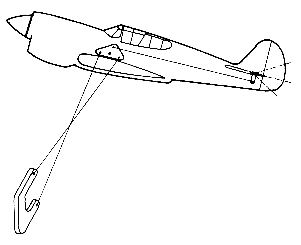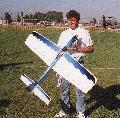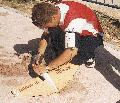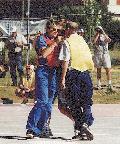|
Introducing Control Line Model Flying |
by Göran Olsson

Visit:
My Main Control Line Page |
Svensk version av denna sida (Swedish version)
|
There is also a Hebrew version!
People in general think of Radio Control as soon as
model aircraft is mentioned, overlooking the two other branches of
aeromodelling, Free Flight and Control
Line. These two branches may lack the appeal of realism that
Radio Control offers, but they compensate by offering unique and
challenging competition opportunities.
What is Control Line?
In this flavor of model flying, C/L in short, also referred to as
U-Control, the models are flown in a circle and
controlled by a pilot in the center holding a handle connected to two
thin steel wires. The wires connect through the inboard wing tip of the
plane to a mechanism that translates the handle movement to the airplane
elevator, allowing maneuvers to be performed along the airplane pitch
axis.
A sketch: By Peter Nyffeler
 The pilot will turn to follow the model going round. (And you
will get dizzy just the first few flights.) The combination of line
length and flying speed is such that the lines are kept straight at a
tension of several times the model weight, and overhead maneuvers are
possible. So that is why I call it "A Hemisphere of Fun". You can
actually reach anywhere on the surface of the hemisphere above you with
a radius equal to the line length.
The pilot will turn to follow the model going round. (And you
will get dizzy just the first few flights.) The combination of line
length and flying speed is such that the lines are kept straight at a
tension of several times the model weight, and overhead maneuvers are
possible. So that is why I call it "A Hemisphere of Fun". You can
actually reach anywhere on the surface of the hemisphere above you with
a radius equal to the line length.
Over the years since its introduction in the late '30:s, control line flying
has developed into a high level competition sport.
Biographies of two Control Line pioneers:
Oba St.Clair
and Jim Walker from the AMA Museum site.
There are four main
contest categories for control line models:
Ther are also other categories, of which I know very little, since they
aren't flown here in Sweden, but I have links to other web pages that
provide information:
The international rules are
defined by the
Fédération Aéronautique Internationale (FAI). World and
Continental (presently only European) Championships are held with
semiannual interleaving. The World
Championships were held here in Sweden in July 1996. 2006
they took place in Valladolid, Spain's and next time 2008 it's France's turn.
In
addition to the international categories there are also national
variants. The international rules are
available from FAI.
The Control Line Contest Categories
Speed
This is the all-out speed event.

World Champion '96, '98', '00, '02, '04 & '06, European Champion '97, '99, '03 & '07:
Luis Parramon, ESP
Swedish Champion '91 - '07 Per Stjärnesund with model
|
Flight is timed over nine laps after the pilot has placed his handle in a
pylon fork at the center, and the speed determined. In the international
class, F2A, engine capacity is 2.5 cc (.15 cu.in.). The flight radius is
17.69 m, (58.04 ft.) making 9 laps equal to 1 kilometer. This was
changed from the previous 15.92 m and 10 laps on 1st July, 1997. Top speeds
are above 300 km/h (190 mph, 311 km/h was the winning speed in the 1996
World Championship, on short lines).
Engines have glow plug ignition, run on restricted fuel (80% methanol,
20% castor oil) and use resonant exhaust systems, "pipes". They operate
at around 36,000 rpm and develop over 2 bhp.
Model designs are very exotic with inboard wing
only and single blade propeller.
There is no undercarriage, but a dolly that is dropped at take-off and a
wire skid for landing. Weight is around 500 g (18 oz.). (Feel free to
calculate the pilot's rotational speed and the line pull on the handle.
Answer.) In addition to the FAI F2A class there
are national classes for engine sizes between .8 cc and 10 cc, as well as
pulse jet engines.
Timekeeping is traditionally manual, but my own development, an
electronic system has become a viable
alternative.
Read more at:
|
Aerobatics
This is precision flying with big, beautiful models.

3:rd, E/Ch '97:
Yuri Yatcenko, UKR
A model by Lars Roos, Trelleborg, Sweden.
|
Also called Stunt. A predetermined flight program
with advanced maneuvers is to be performed, and points are given for the
precision by a panel of referees. The international class, F2B, has a
program of sixteen maneuvers, also involving square and triangular loops
with corners specified at 1.5 m (5 ft.) radius. All maneuvers except the
overhead eight should have their low level at 1.5 m (5 ft.) above ground.
It takes some nerve to do this repeatedly with an airplane that has taken
hundreds of hours to build. Models are often very attractive with a
superb finish.
Wing span is around
1.5 m (6 ft.) and weight 1.5 - 2 kg ( 3-4 lb.). Wings have flaps that
are coupled to the elevator. Line length is 15-21.5 m (50-70.5 ft.).
Flying speeds are around 85 km/h (55 mph). Engines are of 5.6-10 cc
(.35-.60 cu.in.) size and operate at relatively low rpm (9,000) with a
rich fuel setting. As the engine leans out in response to the g forces of
the maneuvers, power increases to compensate for the induced drag and
keep speed up.
There are also various beginner categories on the national level, to match the
skills of every flyer.
|
Read more at:
- PAMPA, the US
interest group.
Team Racing
This is the racing event, involving simultaneous flying and
pitstops.

2:nd, E/Ch '97:
Regis Gilbert, FRA

Final Pilots, E/Ch '97:
Pennisi, ITA,
Ch. Gilbert, FRA,
Titov, RUS
Myself Practising Pitstops.
Pilots in Action (animated GIF)
A model from
Australia: Keith Baddock's (using my wing
outline)
French World Champions 2000, Maret and Perret, describe their
equipment.
|
The international class is F2C. A pilot
and a mechanic compete as a
team to fly small (350 grams)(12 oz.) 65 cm (25 in.)
wingspan semi-scale racing models over a tarmac or concrete surface.
Lines are 15.92 meters long (52.231 ft).
Three pilot + mechanic teams compete
simultaneously in the same circle, and the object is
to finish the determined course as fast as possible. The all-out
important catch is that tank size is limited to 7 cc.
(About one and a half teaspoon.) Thus 2-3 pitstops for refueling are
needed during the race.
The mechanic stands at a pit area outside the marked
flight circle. He will start the engine and release the model at the
start signal and then stand alert for refuelling. The pilot will operate
a fuel shutoff by a quick down elevator movement after the planned
number of laps so that the model can approach the mechanic at optimum
speed, around 50 km/h (30 mph). The mechanic will catch the model by the
wing, fill the tank from a pressurized can by a hose and finger valve.
Then restart the engine by hitting the carbon fiber/epoxy resin
propeller with his finger. Ground time of a good pitstop is less than
three seconds.
The race course is 10 km, corresponding to 100 laps. Flying speeds
are around 200 km/h (125 mph), which means that the pilots have to turn
one lap in 1.8 seconds. Line pull due to centrifugal force is 85 N (17
lb) (19 g:s). A faster model will overtake by the pilot steering it
above the slower one while he moves his handle with lines over the
opponent pilot's head. Conduct of both pilots and mechanics is subject
to numerous regulations. Line tangles aren't as common as you might
think, since the penalty normally is wrecked models. Natural selection
at work. 
After two rounds of elimination heats, the 6, 9 or 12 fastest teams enter
two semifinal rounds, and the three fastest teams in the semifinals go
to the final, which is run over the double course.
Maximum engine size is 2.5 cc (.15 cu.in.). Diesel, i.e. compression
ignition engines are used. They are single cylinder two-stroke, designed
and highly specialized for this purpose. At the world championship level
it is not uncommon that the competitors design and build their own
engines. Their output power is approaching .8 horsepower at 25,000 rpm. A
drawing of engine and tank.
The fuel is
50% kerosene, 35% diethyl ether, 10% castor oil plus various additives,
most notably amyl nitrate 1-3%. (And maybe a few specials, such as my own.) The tank 7 cc capacity leads to fuel
economy tradeoffs to limit the number of pitstops to two. The fuel
system includes a multifunction valve to ensure optimum starting,
running, stopping and refuelling operations.
|
Some model regulations:
Semi-scale appearance; Wing + tailplane area: 12 sq dm. Fuselage at
pilot location: Height 100 mm, width 50 mm, area 39 sq cm. Cabin with
clear windshield and pilot head are mandatory. Landing gear wheel 25 mm
diameter.
Models nowadays normally are of the flying-wing type, and
some think the semi-scale appearance requirement has degenerated. My own design as an example.
Model construction:
Wing: lightweight "quarter grain" balsa with spruce &
abachi reinforcements, glass fiber/epoxy covering. Maximum thickness is
around 7.5 mm (.3")
Fuselage: Either carbon fiber/epoxy shell or
balsa shell plus harder wood reinforcements and glass/epoxy covering.
Other interesting facts:
The aerodynamic drag of the control lines
is more than half of the total drag.
If the pilot holds his handle
30 cm (1 ft.) behind the center of rotation (due to blocking action of
an opponent) this introduces more braking force than the entire drag of
the model.
Fuel and compression settings have to be carefully adjusted by the
mechanic. The compression setting is the means of getting the proper
ignition point, and is extremely difficult do do properly. The slightest
decrease will cause misfire and loss of speed, and the slightest
increase will cause thermal runaway due to pre-ignition.
Simplified classes, such as Goodyear Racing, are also flown in many countries.
Here models are 'profile' fuselage 1/8 scale versions of real racing
aircraft, or profile fuselage versions of F2C models.
My design.
Read more:
Combat
This is man to man dogfight in a control line version.

Top Pilots, E/Ch '97:
Gusev, RUS,
A Beliaev, RUS
Mats Bejhem preparing for a Combat bout.
(40k)
Kozyol, an Ukrainian combat engine.
|
In a circle laid over grass two pilots fly models
that have strings with paper streamers attached to the tail. The object
is to cut the opponent's streamer with your propeller, and to stay
airborne. In the international class, F2D, the pilots are assisted by two
mechanics each and are allowed one spare model per bout.
At the end
of the 4 minute bout period, the cuts and airtime are given points and a
winner of the bout is determined. The contest is run by matching
competitors that haven't collected two losses until a single winner
remains.
The models are able to loop/bunt at 140 km/h (90 mph) with a radius of
less than 2.5 m (8 ft.) at the wiggle of your hand. That's g forces of 70
g:s!
They are at the extreme in simplicity, maneuverability and
durability. Although they are strong enough to often survive ground hits
at full speed, there is a considerable carnage in mid-air collisions
during a competition. To enter a competition you have to bring a model
stock of about half a dozen, except for the engines where three plus a
spare inventory suffice if you bring equipment to clean out the soil from
ground hits. 
|
Model configuration is a flying wing with around 1 meter (3.5 ft.) span,
construction is a spruce/styrofoam/balsa frame covered with mylar film.
An elevator is attached directly to the wing trailing edge. With a
good serial production strategy the building time of a model could come down
to 8 hours. Fuel tank is made from latex rubber tubing that is inserted into
a compartment in the wing and pumped with fuel to resemble a frankfurter.
This 'tank' will give a constant overpressure of around 1 atmosphere to
ensure that fuel is fed to the engine in all maneuvers. Model weight is
around 400 grams (14 oz.). Engines are 2.5 cc glow plug type developing
around 1 bhp at 30,000 rpm on a standard fuel of 70% methanol, 10%
nitromethane and 20% castor oil. Lines are of 15.92 m length. (52.2 ft.)
Combat models could be the most maneuverable things made by man. (Using
the number of controllable g:s as measure.)
More about Combat:
To my:
Control Line Page
|| Control Line Links Page


 The pilot will turn to follow the model going round. (And you
will get dizzy just the first few flights.) The combination of line
length and flying speed is such that the lines are kept straight at a
tension of several times the model weight, and overhead maneuvers are
possible. So that is why I call it "A Hemisphere of Fun". You can
actually reach anywhere on the surface of the hemisphere above you with
a radius equal to the line length.
The pilot will turn to follow the model going round. (And you
will get dizzy just the first few flights.) The combination of line
length and flying speed is such that the lines are kept straight at a
tension of several times the model weight, and overhead maneuvers are
possible. So that is why I call it "A Hemisphere of Fun". You can
actually reach anywhere on the surface of the hemisphere above you with
a radius equal to the line length.



